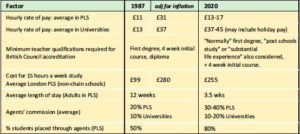Melanie Butler gives her view
After 30 years reporting on English language teaching, I am accustomed to waves of school closures in one English-speaking country or another. The results are predictable: students are stranded, teachers protest; occasionally, national governments get involved.
In the same period, the terms of trade have changed dramatically. To see the difference, look at the table (see below) comparing the situation in London language schools in 1987, when I stopped teaching, and the situation as I see it now.
All language schools in English-speaking countries have been affected, but it seems to me that the US and the UK have been hit hardest.
In the UK, we have seen several closures in recent months among well-established private language schools from the top of the EL Gazette rankings (see this month’s supplement for our latest rankings). Excel English in Muswell Hill, London, closed its doors in September and Lake School of English in Oxford followed suit this January.
The international chains have not been immune: British Study Centres and Eurocentres have each closed one of their London branches, in Hampstead and Eltham respectively. Meanwhile, as we report in this issue, teachers have been out protesting after being made redundant from another London school.
In the US, we have reported on old, established language schools in both Boston and New York shutting their doors within the last year. Last September, one US university language centre laid off all the permanent teaching staff, quoting a steady decline in the length of enrolments. It replaced them with hourly-paid teachers.
Most dramatically, in January 2019, Maltese-owned language school chain EC announced it had bought the British-based Embassy chain of language schools and was closing all Embassy year-round centres in the UK, the US and Canada.
Why is this happening? I see two main factors: courses have gotten shorter, and agents’ commissions have gone up. As a result, profit margins have plummeted, and one way that schools have responded is by bearing down on their teaching costs. In the US and the UK, politically inspired visa changes have made things worse by limiting options for students to work and therefore stay longer.
The length of stay has been dropping since the mid-1990s, when UK language schools were forced to introduce continuous enrolment, as students had begun joining and leaving classes on a weekly basis. Some long-haul markets have continued to enrol
“Profit margins have plummeted and one way that schools have responded is by bearing down on their teaching costs.”
students for periods of three to six months, but students tend to head for destinations which offer part-time work visas.
This is good news for Canada, Australia, Ireland and, most recently, Malta.
But this is bad news for the US and – since the British government withdrew work rights for language students in 2011 – the UK. The high value of the dollar in the US, and political changes to the visa systems in both ‘the big two’, have only made the situation worse.
When long-stay students disappear, so do permanent teaching jobs, although the casualisation of English language teaching is also apparent in these destinations.
This may be partly because the rise in agents’ commissions have hit all the English-speaking countries, while the percentage of students coming through agents has gone up. Moving staff costs from fixed costs to variable costs is a popular move for accountants looking to make the bottom line look better.
But agents aren’t laughing all the way to the bank either. As the average length of stay has dropped, so has the average commission per sale. At the same time, the internet has increased marketing costs and introduced competition from on-line only operators.
With profit margins dropping in both agencies and language schools, the terms and conditions of teachers have gone down.
In the private sector, hourly teaching rates have been dropping steadily in real terms over the last thirty years except in unionised sectors like higher education, and unionised markets like Australia where rates are broadly in line with expectation but casualisation has grown.
Across the world, profit margins have been cut to the quick. Yet teachers remain convinced that schools are raking in money, while their terms and conditions decline. So, they turn to unions and strikes and protests surge. It’s hard to blame them.
Just as it’s hard to blame the American-owned Kaplan International language school chain which announced last year that it had acquired a large multinational agency, and therefore, in locations where it has its own language schools it is unlikely to send students to its rivals.
Thirty years after I came up with the term Language Travel to describe this part of the English Language industry, it looks to me like this business model is broken.






